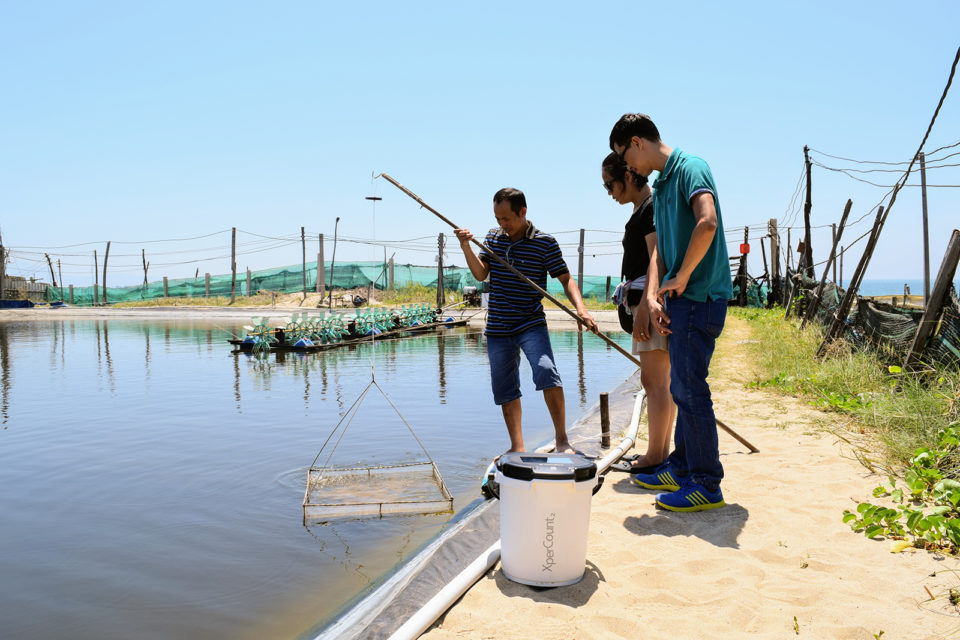XpertSea lines up Aqua-Spark, other investors to grow sales of its ‘magic bucket’

XpertSea CEO Valerie Robitaille is thrilled that the Canadian company she founded with her spouse Cody Andrews just raised CAD $10 million in Series A financing.
Their product, XperCount, uses optics and photonics to deliver a 95 percent accurate count of microorganisms, such as fish or shrimp larvae, in just seconds. It assesses growth and mortality rates of the organisms it counts and provides forecasts, as well.
“The funding is great,” Robitaille said. “But the ultimate validation for us is to see that people are using XperCount in their operations and that it’s really making a difference.”

XperCount is being used at 150 facilities in 48 countries. The devices have counted more than 17 billion organisms and uploaded more than 100,000 counting and sizing sessions to the data portal.
Aqua-Spark, a Netherlands-based impact investment fund focused exclusively on sustainable aquaculture, had been tracking XpertSea’s progress for three years prior to committing to funding.
“We took special notice when we learned our Madagascan sea cucumber farm was using XpertCount and raving about it,” said Aqua-Spark, co-founder Amy Novogratz. “With XperCount, the manual counting of microorganisms – which used to take days – can be done almost instantly and much more accurately.”
XpertSea develops technologies aimed at increasing the profit and sustainability of aquaculture operations. It received funding from Aqua-Spark, Obvious Ventures and Real Ventures, which invested in the company’s seed round.
Robitaille studied marine biology and geoengineering before developing an interest in technology in the fields of optics and photonics. She and Andrews, an engineer, started considering commercial uses for optics and photonics in marine environments and identified a significant technology gap in the aquaculture industry that they set out to address. The pair came up with a solution that seemed a good solution for shrimp, and with funding they received in 2015, built XperCount.
XpertCount is a tank-like device – casually dubbed the “magic bucket” – that sells for $5,000 and holds five gallons of water. Fish farmers place samples from their tanks into the device and within seconds, the number of animals contained is counted and measured using computer vision and algorithms. After several samples XperCount assesses growth and mortality rates and provides forecasts.
Novogratz jumped at the opportunity to invest.
“We haven’t seen a hatchery solution like theirs,” she said. “Tech and data solutions in aquaculture have increased but mainly in the salmon industry, and most new tech is focusing on farming, but not the early stages, where a healthy start is imperative. XpertSea sets itself apart by approaching challenges from the farmer’s perspective and building solutions from the ground up, bringing marine science and industry expertise together with world-class engineering.”

Robitaille said the biggest advantage of the accurate inventory delivered by XpertCount lies in feed management.
“Feed consumes up to 60 percent of an aquaculture farmers’ production costs, and the error rate is 20 to 30 percent,” she said. “Knowing accurate numbers allows you to optimize your feeding regime and your stocking density, and by monitoring growth farmers can make decisions on how to improve production. By contrast, it’s very hard to get accurate counting and sizing of organisms every day using a manual method.”
XpertCount also provides a digital transaction report so that when farmers package their product for their customers, they can deliver it with a more accurate inventory assessment. For shrimp hatcheries selling larvae to producers, for example, knowing the precise number of organisms in a transaction is crucial. Without the magic bucket, getting a precise count was virtually impossible.
Robitaille believes XperCount adds quality control and makes transactions like these more transparent and traceable. By measuring the size of the organisms, the device can also add assurance that they are growing at a consistent rate and prevent the possibility of cannibalism.
XpertSea sets itself apart by approaching challenges from the farmer’s perspective and building solutions from the ground up.
“The objective with digitalizing information is to bring more predictability to production and the industry as a whole,” she said. “I think that will help stabilize the economy, make investments easier and allow practices to improve.”
Novogratz agrees there’s lots of room for improvement in resolving aquaculture production issues and bringing efficiency and transparency to the industry.
“XpertSea’s technology gives farmers much more information to work with, which enables them to distribute feed more accurately, to better monitor growth rate and assess disease risk,” she said.
The Series A funding will give XpertSea the ability to expand its offering beyond the shrimp hatcheries where it is mainly focused to date and provide solutions for tilapia and shellfish farms and for marine fish hatcheries and nurseries. Robitaille said the company already has customers using XperCount for marine fish solutions “but we have to do more quality control and make sure it works for all different use cases before we can release it commercially,” she said. That solution is just months away from being launched.
“I’m glad we’ve built something that’s useful and has potential to have an impact on an industry that’s so important in feeding the world,” she said. “But we’re only at the beginning of what we want to do at XpertSea. We hope to work with industry collaborators and partners who need data for aquaculture and to build architecture and products that others can also leverage.”
Follow the Advocate on Twitter @GAA_Advocate
Author
-

Lauren Kramer
Lauren Kramer is a freelance journalist residing in Richmond, B.C., who has written extensively about seafood marketing for SeaFood Business magazine and SeafoodSource.com. Her work appears in a number of publications, including the National Culinary Review and Flavor & The Menu.
Tagged With
Related Posts

Health & Welfare
Pellet-based oral vaccine holds promise for VNN protection
An oral vaccine delivered via fish feed to defend against Viral Nervous Necrosis could be ready for market soon if everything goes according to plan for startup VakSea.

Innovation & Investment
Aquaculture data-collection app provides cloud coverage
Aquanetix, launched by two fish biologists, employs cloud technology for electronic data collection, enabling farmers to monitor infrastructure, minimize feed losses and make informed operational business decisions based on real-time reports about their stocks.

Innovation & Investment
Microalgae into medicine: Biotech startup targets shrimp, salmon diseases
MicroSynbiotiX is employing the power of transgenic microalgae to make it cheaper and easier for aquaculture producers to administer vaccines to fish.

Aquafeeds
A new nutrient for aquaculture, from microbes that consume carbon waste
Biotechnology firm NovoNutrients aims to produce a line of nutraceutical aquafeed additives as well as a bulk feed ingredient that can supplement fishmeal. Its process includes feeding carbon dioxide from industrial gas to a “microbial consortium” starring hydrogen-oxidizing bacteria.

